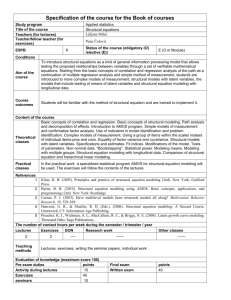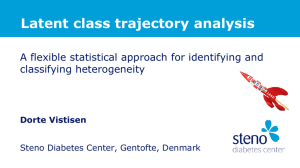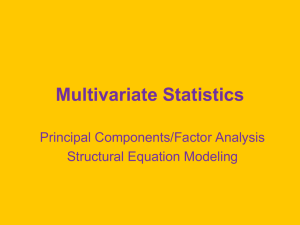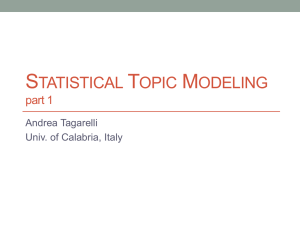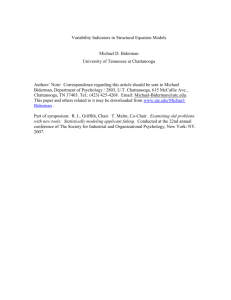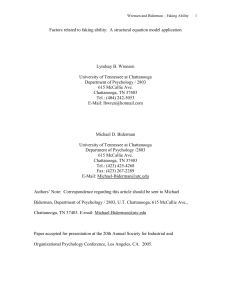P5950 Lecture 11 - Structural Models
advertisement
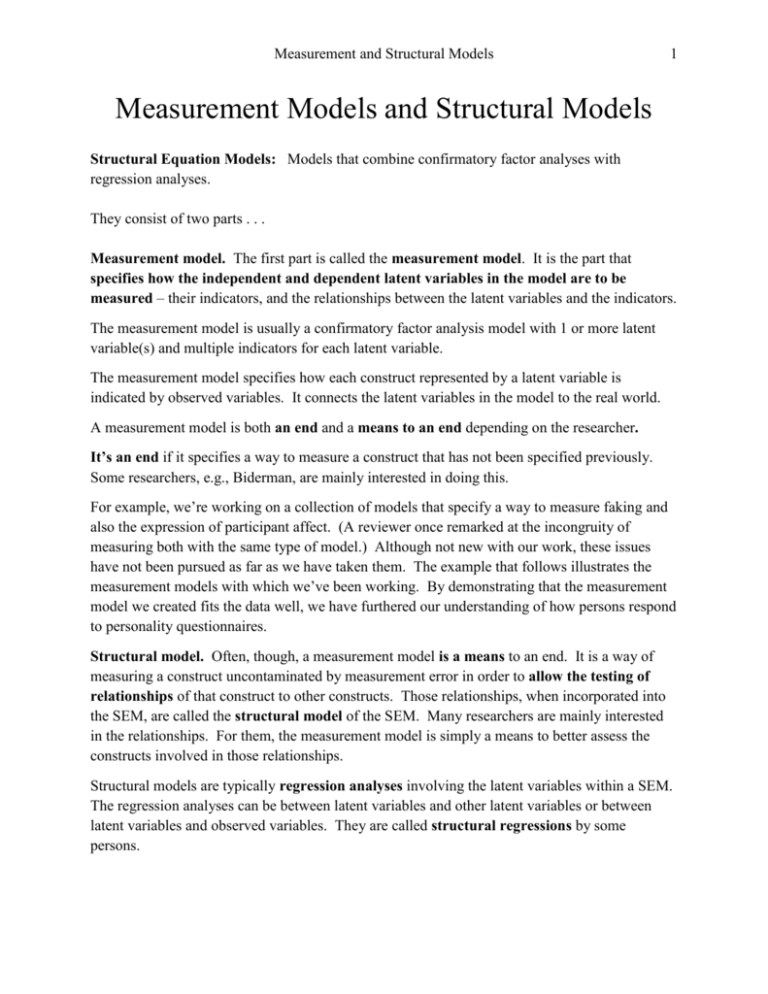
Measurement and Structural Models 1 Measurement Models and Structural Models Structural Equation Models: Models that combine confirmatory factor analyses with regression analyses. They consist of two parts . . . Measurement model. The first part is called the measurement model. It is the part that specifies how the independent and dependent latent variables in the model are to be measured – their indicators, and the relationships between the latent variables and the indicators. The measurement model is usually a confirmatory factor analysis model with 1 or more latent variable(s) and multiple indicators for each latent variable. The measurement model specifies how each construct represented by a latent variable is indicated by observed variables. It connects the latent variables in the model to the real world. A measurement model is both an end and a means to an end depending on the researcher. It’s an end if it specifies a way to measure a construct that has not been specified previously. Some researchers, e.g., Biderman, are mainly interested in doing this. For example, we’re working on a collection of models that specify a way to measure faking and also the expression of participant affect. (A reviewer once remarked at the incongruity of measuring both with the same type of model.) Although not new with our work, these issues have not been pursued as far as we have taken them. The example that follows illustrates the measurement models with which we’ve been working. By demonstrating that the measurement model we created fits the data well, we have furthered our understanding of how persons respond to personality questionnaires. Structural model. Often, though, a measurement model is a means to an end. It is a way of measuring a construct uncontaminated by measurement error in order to allow the testing of relationships of that construct to other constructs. Those relationships, when incorporated into the SEM, are called the structural model of the SEM. Many researchers are mainly interested in the relationships. For them, the measurement model is simply a means to better assess the constructs involved in those relationships. Structural models are typically regression analyses involving the latent variables within a SEM. The regression analyses can be between latent variables and other latent variables or between latent variables and observed variables. They are called structural regressions by some persons. Measurement and Structural Models 2 Example 1A: A measurement model for Big Five personality characteristics and a faking characteristic. Below is an example of a measurement model from Wrensen & Biderman (2005). Participants responded to a Big Five questionnaire twice – once under instructions to respond honestly, again under instructions to “fake good”. The model specifies how the Big Five latent variables and a faking latent variable are to be measured. Mike – Discuss it in detail, including the two types of correlated residuals. Measurement Model Chi-square = 564.595 df = 350 p = .000 CFI = .938 GFI = .838 RMSEA = .058 .77 .88 .82 .87 E .27 .22 .24 .18 HETL1.67 e1 HETL2.77 e2 HETL3.40 e3 FETL1.16 e4 .55 FETL2 .57 .63 .42 e5 FETL3 e6 .17 .19 .17 .26 .51 A .04 .93 .28 .46 .18 e7 HATL2.08 e8 HATL3.21 e9 FATL1.08 .12 .20 .00 HATL1.86 FATL2 .02 FATL3 C -.08 .29 .12 .27 FA represents .33 variance in the F testlets that is a) common across all 5 dimensions and b) not attributable to any of the Big Five characteristics. It’s a Faking Ability factor. S .76 .34 .07 .57 .22 .10 .84 .72 .80 .77 .31 .26 .33 .75 .65 .66 .27 .19 FA .27 .60 .63 .10 e11 e12 HCTL2.53 e14 HCTL3.66 e15 FCTL3 .74 .28 -.05 .35 e10 e13 FCTL2.62 .89 O .40 .11 HCTL1.63 FCTL1.67 .09 .78 .77 .88 .79 .73 .76 .17 .17 .69 .17 .12 .03 e16 .07 e17 .39e18 .71 HSTL1 e19 .79 HSTL2.55 e20 HSTL3.63 e21 FSTL1.64 .09 e22 FSTL2.53 FSTL3 .08 e23 .15 .38e24 .71 .79 HOTL1.62 e25 .57 HOTL2.33 e26 HOTL3.51 e27 FOTL3 .66 .15 .84 FOTL1.43 FOTL2.43 These covariances are estimated separately because they’re assumed to reflect similarities in responses due to similarities in item wording. .71 .16 .09 e28 -.03 e29 .22 e30 .21 These covariances are estimated separately because they’re assumed to reflect slight differences in faking specific to the Big Five dimensions. We included them to improve goodness-offit values. We’ve since quit estimating them, although the issue needs to be revisited. Measurement and Structural Models 3 Example 1B. Adding a Structural model of faking ability to the above measurement model. The following schematic path diagram shows the measurement model above along with a structural model relating faking ability to Cognitive Ability, Emotional Intelligence, Integrity, Social Desirability, Self Monitoring, and the Order within the research procedure that the faking instructions occurred (1st vs. 2nd). The structural model is in red. In this case, the structural model is between exogenous observed variables and the endogenous Faking Ability latent variable. Mean of 3 standardized loadings: .88, .82, .87 (see above). .85 E H-E .18 Mean of 3 residual correlations. .25 .55 .26 C .51 F-E .55 A H-A .39 .80 .14 .37 S .07 F-A H-C .30 .83 .43 .71 O .74 CA .19* EI .16* F-C H-S .19 .30 .37 .18* .56 .21 F-S FA INT H-O -.24* SD -.02 .49 F-O .37 .06 SM -.13 Order CA: Cognitive ability; EI: Emotional Intelligence; INT: Integrity; SD: Social Desirability; SM: Self Monitoring; Order: Order of presentation of H and F conditions. Notice that all of the regression relationships are partial, since we performed a multiple regression. The CA->FA relationship has been replicated a couple of times – Smarter people are better able to fake when told to do so. Measurement and Structural Models 4 Example 2. From Biderman, Nguyen, Mullins, & Luna (2008). 2A. Here is the measurement model. It’s similar to the above measurement model, with the exception that it’s from only one administration of the Big Five. The model here was applied to data obtained under instructions to respond honestly. So the latent variable that represents variance not attributable to the Big Five is called M, for Method Bias. (We now know that it’s more than method bias, but the letter ,M, has stuck.) E1 E2 E3 E4 E5 E6 E7 E8 E9 E10 M A1 A2 A3 A4 A5 A6 A7 A8 A9 A10 C1 C2 C3 C4 C5 C6 C7 C8 C9 C10 S1 S2 S3 S4 S5 S6 S7 S8 S9 S10 O1 O2 O3 O4 O5 O6 O7 O8 O9 O10 E A C S O The model applied here is called a bifactor model. It’s called that because each observed variable has two (hence “bi”) latent variables influencing it. The first is the trait latent variable. For example, each Extraversion item is influenced by the trait of Extraversion. But each item is also influence by a 2nd latent variable – called M in this model. Having each observed variable influenced by two latent variables is what causes a model to be called a bifactor model. Bifactor models are not well known in the CFA or SEM literature, although they’re gaining in popularity. See Reise, S. P. (2012). The rediscovery of bifactor measurement models. Multivariate Behavioral Research, 47, 667-696. Measurement and Structural Models 5 2B. The Structural Model. Predicting supervisor ratings of performance. In this diagram, I have made only the regression links of the structural model red. All of the Big Five latent variables and M are part of both the measurement model and the structural model. E1 E2 E3 E4 E5 E6 E7 E8 E9 E10 A1 A2 A3 A4 A5 A6 A7 A8 A9 A10 C1 C2 C3 C4 C5 C6 C7 C8 C9 C10 S1 S2 S3 S4 S5 S6 S7 S8 S9 S10 O1 O2 O3 O4 O5 O6 O7 O8 O9 O10 M .174c E -.011 A -.104 -.102 Cus ts P Sal es Col ls C -.142a S -.134a We found M was the best predictor of Supervisor Ratings. We were puzzled about that until recently when we discovered that under instructions to respond honestly, M appears to represent O the respondent’s affective state. Thus, persons with positive affective states (happy people) had higher ratings than those with negative affective states.




